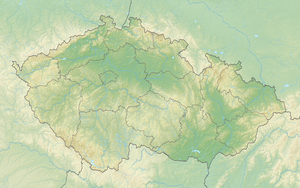Vítkův hrádek
| Vítkův hrádek | ||
|---|---|---|
|
Wittinghausen ruins |
||
| Alternative name (s): | Wittinghausen, Wittigstein | |
| Creation time : | around 1220 | |
| Conservation status: | ruin | |
| Place: | Svatý Tomáš | |
| Geographical location | 48 ° 38 '42.2 " N , 14 ° 6' 11.8" E | |
|
|
||
Vítkův hrádek , also Vítkův kámen (German Wittinghausen , also Wittigstein ) is a castle ruin north of Svatý Tomáš / St. Thomas in the municipality of Přední Výtoň in the Okres Český Krumlov in the Czech Republic .
geography
The ruins of the Vítkův hrádek castle are located between the Vltava reservoir in the north and the state border with Austria in the south on the summit of Vítkův Kámen (1035 m) in the Šumava protected landscape area in the Bohemian Forest . In 2006, a viewing platform was opened in the castle ruins, which allows a wide panoramic view of the Czech Republic and Austria.
history
The castle was probably from the Witigonen I. Witiko of Cesky Krumlov ( Vítek z Krumlova, ze Sepekova such Načeradce founded). It formed the administrative center of the newly settled domination of the same name and at the same time served to secure the domain that extended to Austrian territory. After the Krumau line of the Witigonen died out, Wittinghausen came to the Rosenberger family branch in 1302 . During the quarrels between the Bohemian nobility and King Wenceslaus , he was imprisoned in the castle for a short time in 1394. Around this time the Wittinghausen rule consisted of 15 villages and a glassworks.
In 1427 Ulrich II von Rosenberg pledged Wittinghausen Castle with the German court to his brother-in-law Reinprecht von Walsee , whose son of the same name gave the rule together with the Haslach market in 1464 to Johann II von Rosenberg . King Vladislav II confirmed this donation for John's sons in 1483, after which the Wittinghausen rule was incorporated into the Krumlov rule . Due to financial difficulties, the last Rosenberg, Peter Wok von Rosenberg, had to sell the castle and rule of Wittinghausen together with the rule of Krumlov to Emperor Rudolf II in 1602 .
During the Thirty Years War , the castle was captured by the imperial army in 1621 and passed to the Eggenbergs a year later , who expanded the fortifications. In 1719 the Eggenberg possessions passed to the Prince Schwarzenberg . They arranged for the preserved parts of the castle and the tower to be preserved. In the middle of the 18th century the castle was no longer inhabited.
In 1815 a staircase to the observation tower on the summit was built in the south-eastern part of the castle and repairs were later carried out to secure the tower.
During the time of communist rule (1945–1989) the castle ruins , which were located in the restricted area of the border because of their proximity to Austria , were not accessible.
Adalbert Stifter's story Der Hochwald plays around the castle and the surrounding area . His historical novel Witiko begins with Wittinghausen Castle, which he has built in the novel as "Burg Witikohaus".
Reign of Wittinghausen
The villages of Asang ( Jasánky ), Bernek ( Pernek ), German Reichenau , Kapellner Waldhäuser ( Kaplické Chalupy ), Muckenschlag ( Mukenslag ), Multerberg ( Mezilesí ), Multerberger Waldhäuser ( Multerberské Chalupy ), Linden ( Linda ), Lindner Waldhäuser belonged to the Wittinghausen rule ( Lindské Chalupy ), Murau ( Murov ), Ober Markschlag ( Horní Hraničná ), Ottenschlag ( Otov ), Reiterschlag , Rosenau ( Rožnov ), St. Thomas ( Svatý Tomáš ), Unter Markschlag ( Dolní Hraničná ), Uresch ( Horní Ureš ) and Front of Heuraffl .
The rustic villages of Asang (with Murau), Bernek, German Reichenau, Linden, Muckenschlag, Ober Markschlag (with Hadernthal and Straßbauer), Ottenschlag (with Binder and Reuth), Reiterschlag, Rosenau, Multerberg, Unter Markschlag and Uresch formed the parish of German Reichenau German court , which the Austrian side called the Bohemian court . The Dominikaldörfer Multerberger Waldhäuser (with Kapellner Waldhäuser and Waldbauer), St. Thomas (with Löffler and Rosenhügel) and Vorder Heuraffl were subordinate to the Heuraffl court.
Almost all of the villages were razed to the ground after 1950 because of the iron curtain.
Individual evidence
- ^ Johann Gottfried Sommer : The Kingdom of Böhmen, Vol. 9, Budweiser Kreis , 1841, p. 210
- ↑ Johann Gottfried Sommer : The Kingdom of Bohemia, Vol. 9, Budweiser Kreis , 1841, pp. 250-252
Web links
- The small castle "Vítkův hrádek" . In: Online encyclopedia encyklopedie.ckrumlov.cz about Krummau (history and description of the castle ruins).
- Description of the castle on vitkuvhradek.cz (Czech).
- Description of the castle on hrady.cz (Czech).

